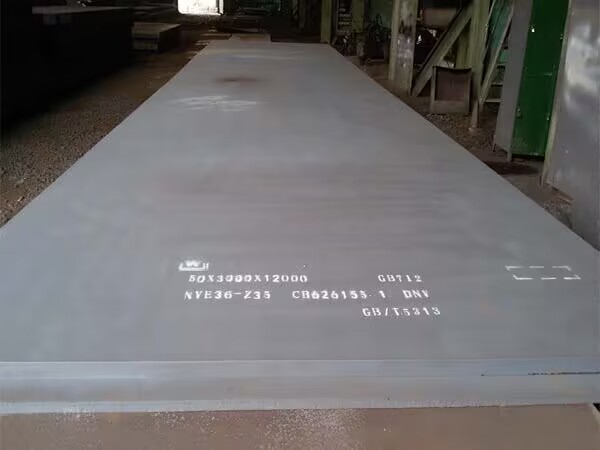Shipbuilding steel plate refers to the carbon steel and alloy steel plate used in offshore and Marine engineering, and its classification is mainly based on its strength grade, toughness grade, and the relevant classification society certification standards. Common grades are A, B, D, E, AH32/36/40, DH32/36/40, EH32/36/40.

Shipbuilding steel plates can be divided into the following three categories according to yield strength:
(1) Normal Strength Steel Plates
According to the ambient temperature, shipbuilding steel plates are divided into different toughness levels:
Grade A steel plate: suitable for normal temperature environment, minimum toughness requirements.
Shipbuilding steel plates need to meet different international classification society standards, usually certified by the following authorities:
American Bureau of Shipping (ABS) : such as ABS A and ABS AH36.
4. Chemical composition
(1)Common strength grade (ABS A/B/D/E)
Generally, the upper limit of carbon content is approximately 0.21%, manganese is about ≤1.3%, silicon is 0.10-0.50%, and phosphorus and sulfur are strictly controlled at ≤0.035%. Some high-toughness grades (such as D and E) also add ≥0.015% aluminium for deoxidation and grain refinement.
(2)High-strength grades (such as AH36 / DH36 / EH36)
|
Elements |
C |
Mn |
Al |
Si |
P |
S |
|---|---|---|---|---|---|---|
|
AH32 |
≤0.18 |
0.7~1.60 |
≥0.015 |
0.10~0.50 |
≤0.04 |
≤0.04 |
|
DH32 |
≤0.18 |
0.90~1.60 |
≥0.015 |
0.10~0.50 |
≤0.04 |
≤0.04 |
|
EH32 |
≤0.18 |
0.90~1.60 |
≥0.015 |
0.10~0.50 |
≤0.04 |
≤0.04 |
|
AH36 |
≤0.18 |
0.7~1.60 |
≥0.015 |
0.10~0.50 |
≤0.04 |
≤0.04 |
|
DH36 |
≤0.18 |
0.90~1.60 |
≥0.015 |
0.10~0.50 |
≤0.04 |
≤0.04 |
|
EH36 |
≤0.18 |
0.90~1.60 |
≥0.015 |
0.10~0.50 |
≤0.04 |
≤0.04 |
5. Mechanical properties
|
Mechanical Properties |
|||||||
|---|---|---|---|---|---|---|---|
|
Steel Grade
|
Thickness/mm
|
Yield point/ MPa |
Tensile strength/ MPa |
Elongation/ % |
V-type impact test |
||
|
Temperature/ ℃ |
Average impact absorption workAkv/J |
||||||
|
Vertical |
Horizontal |
||||||
|
A |
≤50 |
≥235 |
400~490 |
≥22 |
- |
- |
- |
|
B |
≤50 |
≥235 |
400~490 |
≥22 |
0 |
≥27 |
≥20 |
|
D |
≤50 |
≥235 |
400~490 |
≥22 |
-10 |
≥27 |
≥20 |
|
E |
≤50 |
≥235 |
400~490 |
≥22 |
-40 |
≥27 |
≥20 |
|
AH32 |
≤50 |
≥315 |
440~590 |
≥22 |
0 |
≥31 |
≥22 |
|
DH32 |
≤50 |
≥315 |
440~590 |
≥22 |
-20 |
≥31 |
≥22 |
|
EH32 |
≤50 |
≥315 |
440~590 |
≥22 |
-40 |
≥31 |
≥22 |
|
AH36 |
≤50 |
≥355 |
490~620 |
≥22 |
0 |
≥34 |
≥24 |
|
DH36 |
≤50 |
≥355 |
490~620 |
≥22 |
-20 |
≥34 |
≥24 |
|
EH36 |
≤50 |
≥355 |
490~620 |
≥22 |
-40 |
≥34 |
≥24 |
6. Supplement and Explanation
The meanings of the letters in the grades: The letters A/B/D/E/F represent the minimum test temperature, which determines the applicable environment for toughness. The numbers (32/36/40) represent the yield strength class (corresponding to approximately 32, 36, and 40Ksi respectively).
Delivery status process: Low-toughness steels (such as D/E/F, etc.) are usually treated with TMCP, controlled rolling or normalizing to ensure high toughness at low temperatures. F-grade materials (such as FH36) are typically quenched and tempered (QT) to meet the requirements of extreme low-temperature toughness.
The corresponding relationship of classification society certification: Generally, the same grade of steel can be recognized by multiple classification societies, but production, testing and certification must be carried out in accordance with the rules of each institution. For example, "CCS EH36" and "ABS EH36" have the same principle, but the certification process and report format are different.
Summary
Mainstream classification: Structural steel grades are divided into general strength (A/B/D/E) and high strength (AH/DH/EH/FH) based on strength and impact toughness.
The material selection basis for each grade: environmental temperature (especially in low-temperature icy sea areas), stress requirements of structural parts, thickness range, welding and processing methods, etc.
Standards and processes: Usually in accordance with the norms of classification societies such as CCS, ABS, DNV, and GL, the blanking needs to indicate the delivery status and performance requirements. Generally, processes such as TMCP or controlled rolling are used.
Read more :ASTM A36 plates VS ASTM A572 grade50 plates